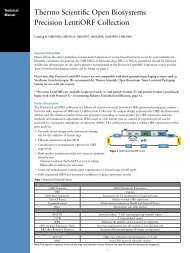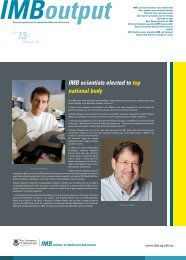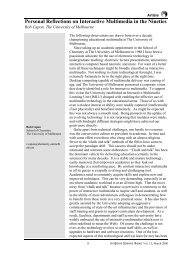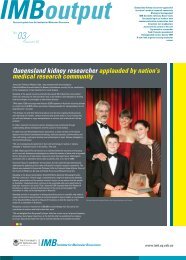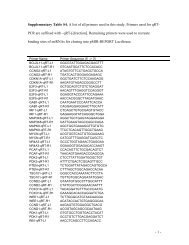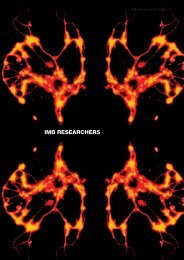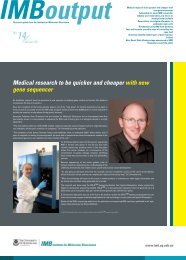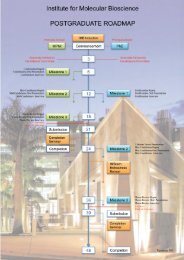2010 Annual Report - Institute for Molecular Bioscience - University ...
2010 Annual Report - Institute for Molecular Bioscience - University ...
2010 Annual Report - Institute for Molecular Bioscience - University ...
You also want an ePaper? Increase the reach of your titles
YUMPU automatically turns print PDFs into web optimized ePapers that Google loves.
imb annual report <strong>2010</strong><br />
10<br />
IMB HIGHLIGHTS <strong>2010</strong><br />
RESEARCHERS DELVE INTO<br />
GENETIC CODE OF TUMOURS IN<br />
HUNT FOR CANCER THERAPIES<br />
Australian scientists are playing a vital<br />
role in a worldwide search <strong>for</strong> cancer<br />
therapies, described in top scientific<br />
journal Nature. The scientists are part<br />
of the International Cancer Genome<br />
Consortium (ICGC), a group of<br />
researchers from 22 countries who are<br />
conducting large-scale studies on the<br />
genomes of different tumour types.<br />
The ICGC members will together<br />
sequence the genetic codes of 25,000<br />
tumours from 50 different types of<br />
cancer over five years. Professor Sean<br />
Grimmond is leading the Australian<br />
team, responsible <strong>for</strong> sequencing<br />
pancreatic and ovarian tumours.<br />
“We have identified changes in the<br />
genetic code from normal tissues to<br />
tumours, but we don’t yet know if these<br />
changes are responsible <strong>for</strong> disease,”<br />
Professor Grimmond said. “Our next<br />
step is running tests in the lab to<br />
determine if these genetic changes have<br />
a biological effect. We will do this <strong>for</strong><br />
every tumour we sequence over the fiveyear<br />
project.”<br />
SOWING THE SEEDS OF MALE<br />
FERTILITY<br />
Australian scientists have discovered<br />
the chemical signals that ensure men<br />
produce sperm instead of eggs. Dr<br />
Josephine Bowles and Professor Peter<br />
Koopman led a team that found that<br />
a protein called FGF9 promotes the<br />
production of sperm in males while<br />
suppressing the development of eggs.<br />
“It sounds obvious, that men produce<br />
sperm and women produce eggs,”<br />
Dr Bowles said. “But sperm and eggs<br />
start out as identical cells, and it’s only<br />
through a complex process of signals<br />
that these cells end up as sperm in men<br />
and eggs in women.”<br />
GENOME EXPLORATION FINDS KEYS TO GENE REGULATION AND<br />
DISEASE<br />
A deep genome exploration has<br />
found tens of thousands of tiny<br />
pieces of genetic material, less that<br />
one percent of the length of the<br />
average gene, that may regulate<br />
gene expression and disease.<br />
Professor John Mattick and Dr Ryan<br />
Taft (pictured) from IMB, and Dr Cas<br />
Simons from the Queensland Facility<br />
<strong>for</strong> Advanced Bioin<strong>for</strong>matics, showed<br />
that these ‘tiny’ RNA molecules are<br />
abundant at the start of genes and<br />
discovered they are also found at<br />
gene splice sites, where genes are<br />
turned on or off.<br />
The work was published in the<br />
premier scientific journal Nature<br />
Structural and <strong>Molecular</strong> Biology,<br />
and led to Dr Taft being named a<br />
finalist in the Eureka Prizes Early<br />
Career Research and People’s<br />
Choice Awards.




